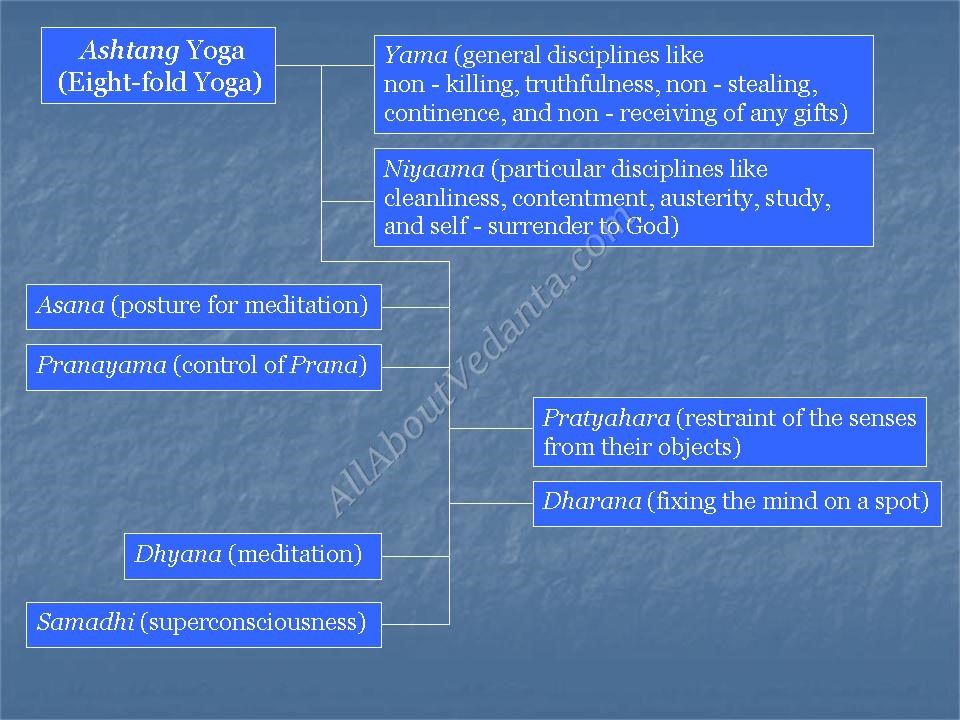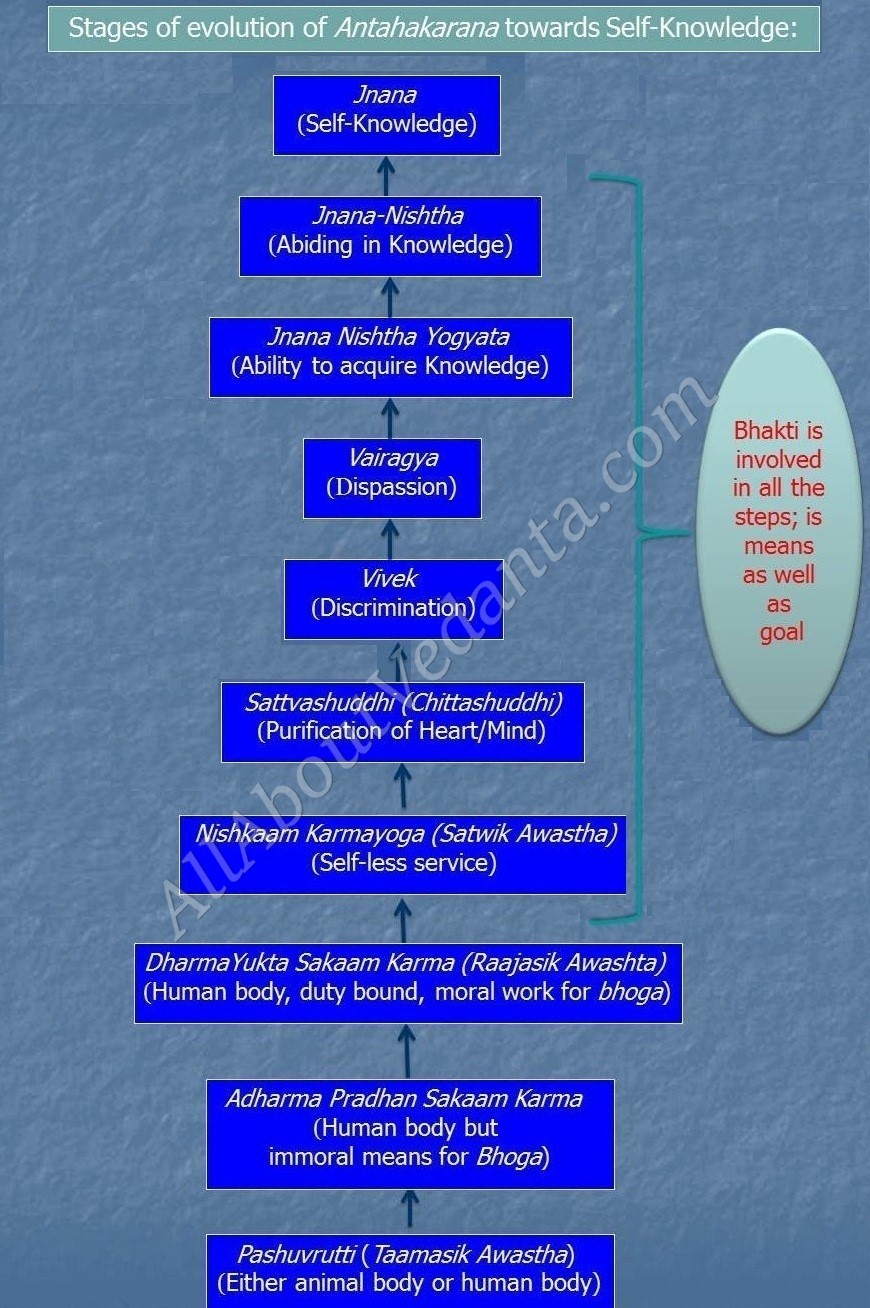
Vedanta
Ways to Goal
We can get rid of the 'Superimposition' completely and realize our absolute, death-less, infinite, real nature by the process described in 'De-Superimposition' i.e. by hearing about the Truth (श्रवण Shravana), then cogitating on It (मनन Manana), and finally continuously meditating on It (निदिध्यासन Nididhyasan). Apart from this Vedantic approach there are various other 'Paths' to the goal of Pure Consciousness depending on the aspirant's psychological make-up. Let us take a brief look at some of these paths.
Each human personality is endowed with following faculties: Emotional, Intellectual, Physical, and Psychic. The proportion of these faculties within an individual is varied. Taking into consideration these faculties, Swami Vivekananda has divided the path to Pure Consciousness in following four broad categories: भक्ति योग Bhakti Yoga or the path of devotion, ज्ञान योग Jnana Yoga or the path of inquiry, कर्म योग Karma Yoga or the path of selfless work, and राज योग Raja Yoga or the path of psychic control.
Bhakti Yoga is based on feelings and emotions that each human being has; ordinarily these are directed towards external objects
and persons but when these are focused on God - the in-dweller of all beings - devotion is developed in mind which makes its
concentration and purification easier. God can be loved with form or without form. All the human relationships can be superimposed
on God and His/Her vision accordingly can be realized. This seems natural and less violent to 'human conditioned' nature as the
path taken is gradual and attachments are dropped slowly. Surrendering our personality in all aspects to the divine, slowly removes
the 'ignorance' from our hearts; God is then realized as manifesting in and through entire creation.
For detail notes on the book 'Bhakti-Yoga' by Swami Vivekananda, please visit: Bhakti-Yoga Notes
Jnana Yoga appears violent and intimidating compared to Bhakti Yoga as it tries to remove 'ignorance' root and branch,
all in one-go! Further it relies on self-enquiry and will-power rather than Divine Grace and surrender. But it is most rational and
hence Swami Vivekananda says, 'Only the path of Jnana is of quick fruition and the rational of all other creeds; hence it is equally
esteemed in all countries and all ages.' In modern times Ramana Maharshi and Nisargadatta Maharaj have stressed this approach.
For detail notes on the book 'Jnana-Yoga' by Swami Vivekananda, please visit: Jnana-Yoga Notes
Karma Yoga appears easy to the work addicted human being of modern age but is in fact very difficult to practice in all
sincerity. Generally human beings are not inclined to perform any action unless they have some interest in the results of that
action; 'work for work sake' or 'work as worship' seem difficult for a desire-laden mind. Karma Yoga asks for an attitude
of detachment and selflessness while performing any action; work thus done clears the impurities of psyche and makes it capable
of approaching Reality. Sri Krishna, in Bhagawad-Gita, explains this in detail and in modern times Swami Vivekananda has highlighted
this Yoga.
For detail notes on the book 'Karma-Yoga' by Swami Vivekananda, please visit: Karma-Yoga Notes
Raja Yoga is considered difficult to practice in modern times, but its approach is very methodical and free from any pre-conceived beliefs. 'The science of Raja-Yoga proposes to put before humanity a practical and scientifically worked out method of reaching this truth' says Swami Vivekananda. The path requires great training of the mind and rigorous application of discipline. Many aspects of it are based on the aphorisms of Sage Patanjali.
|
Raja Yoga consists of main eight parts and hence it is referred as Eight-fold Yoga (अष्टाङ्ग योग
Ashtanga-Yoga). These are described in brief by Swami Vivekananda as: 'Raja-Yoga is divided into eight steps. The first is
Yama - non-killing, truthfulness, non-stealing, continence, and non-receiving of any gifts. Next is Niyama - cleanliness, contentment,
austerity, study, and self-surrender to God. Then comes Asana, or posture; Pranayama, or control of Prana; Pratyahara, or
restraint of the senses from their objects; Dharana, or fixing the mind on a spot; Dhyana, or meditation; and Samadhi, or
superconsciousness.' |
Steps in Sadhana
Vedanta understands the difficulty faced by the conditioned human consciousness to grasp the infinite Reality; hence there is a graded approach to reach the goal. In first step of साधना Sadhana (spiritual practice), the aspirant considers himself/herself entirely separate from the infinite divine; this is Dualism (द्वैत Dvaita). As the sadhana matures, the aspirant begins to feel that he/she is an inseparable part of the divine; this is Qualified Non-dualism (विशिष्ट-अद्वैत Vishishtaadvaita). Last and most profound is Non-dualism (अद्वैत Advaita) in which the aspirant realizes his/her identity with the infinite Self. Advaita is the last word in spirituality and unique contribution of Indian philosophy to entire humanity. Though there have been many saints, prophets, and incarnations all around the world who realized the state of identity with God, Advaita as an accepted philosophy and way of Sadhana became popular only in India. Upanishads, the source of spirituality, proclaim all the three steps to the goal but they in particular emphasize the non-dual nature of Truth.
Advaita is subtle and even scholars find it hard to properly understand. It is neither Realism (Empiricism) nor Idealism (Rationalism) but an existential fact; in the words of Swami Vivekananda, '[Maya] is neither Idealism nor Realism, nor is it a theory. It is a simple statement of facts - what we are and what we see around us.' Many philosophers and spiritual seekers fail to understand this subtle point and thus remain skeptical about Advaita Vedanta; some mistake Advaita with Solipsism while others with Nihilism. Failing to recognize the substratum and very foundation of gross and subtle existence, science and some religions tangle themselves in debate of superiority/inferiority of mind v/s matter. If Pure Consciousness is recognized as the source of gross and subtle, of mind and matter, then everything is beautifully harmonized and understood. Swami Vivekananda says:
'The materialist frightens the idealist by claiming to derive his mind from the elements of the laboratory, while all the time he is struggling to express something higher than all elements and atoms, something of which both the external and the internal phenomena are results, and which he terms matter. The idealist, on the other hand, wants to derive all the elements and atoms of the materialist from his own thought, even while catching glimpses of something which is the cause of both mind and matter, and which he ofttimes calls God. That is to say, one party wants to explain the whole universe by a portion of it which is external, the other by another portion which is internal. Both of these attempts are impossible. Mind and matter cannot explain each other. The only explanation is to be sought for in something which will embrace both matter and mind.'
Advaita also gives us broad outlook and saves us from narrow and fanatical judgments. The tolerant and assimilative nature of Indian culture owes its debt to Advaita.
Kundalini
Apart from the four broad yogas mentioned above there are numerous other ways to approach the divine; in fact Swami Vivekananda says that 'there are infinite ways of practicing yoga'. Followers of Agamas [for various aspects of Hindu scriptures please see Sanatana Scriptures] especially Shakta Agamas (Tantra) refer to Kundalini Shakti and it's passing through six chakras (psychic centers located in subtle body) to reach the goal of Pure Consciousness. Kundalini is the coiled-up power of the divine in all of us which remains dormant in most of the humanity. It can be aroused through proper spiritual practice and then it rises up to reach the chakra in head called Sahasrara (thousand-petalled) completing an aspirant's spiritual journey. Sri Ramakrishna has described this experience in his simple and clear words as:
Yoga is not possible if the mind dwells on 'woman and gold'. The mind of a worldly man generally moves among the three lower centres:
those at the navel, at the sexual organ, and at the organ of evacuation. After great effort and spiritual practice the Kundalini
is awakened. According to the yogis there are three nerves in the spinal column: Ida, Pingala, and Sushumna. Along
the Sushumna are six lotuses, or centres, the lowest being known as the Muladhara. Then come successively
Svadhisthana, Manipura, Anahata, Visuddha, and Ajna. These are the six centres. The Kundalini, when awakened,
passes through the lower centres and comes to the Anahata, which is at the heart. It stays there. At that time the mind of
the aspirant is withdrawn from the three lower centres. He feels the awakening of Divine Consciousness and sees Light. In mute
wonder he sees that radiance and cries out: 'What is this? What is this?'
After passing through the six centres, the Kundalini reaches the thousand petalled lotus known as the Sahasrara,
and the aspirant goes into samadhi.
According to the Vedas these centers are called 'bhumi','planes'. There are seven such planes. The center at the heart corresponds
to the fourth plane of the Vedas. According to the Tantra there is in this centre a lotus called Anahata, with twelve petals.
The centre known as Visuddha is the fifth plane. This centre is at the throat and has a lotus with sixteen petals. When the
Kundalini reaches this plane, the devotee longs to talk and hear only about God. Conversation on worldly subjects, on
'woman and gold', causes him great pain. He leaves a place where people talk of these matters.
Then comes the sixth plane, corresponding to the centre known as Ajna. This centre is located between the eyebrows and it has
a lotus with two petals. When the Kundalini reaches it, the aspirant sees the form of God. But still there remains a slight
barrier between the devotee and God. It is like a light inside a lantern. You may think you have touched the light, but in reality
you cannot because of the barrier of glass.
And last of all is the seventh plane, which, according to Tantra, is the centre of the thousand-petalled lotus. When the Kundalini
arrives there, the aspirant goes into samadhi. In that lotus dwells Satchidananda Siva, the Absolute. There Kundalini,
the awakened Power, unites with Siva. This is known as the union of Siva and Sakti.
Irrespective of the path taken towards the goal, the general development of mind can be graded as shown in diagram below:
Thus through various ways all aspirants reach the same goal. Religions, sects, philosophers, and preachers across the world have offered diverse paths to liberation; whichever path we take, the essential thing that matters for success is same everywhere: Sincerity and Earnestness.
(For further study of the topic kindly refer to books published by Ramakrishna Math and Ramakrishna Mission, Chinmaya Mission, and others on Upanishads, Bhagawad-Gita, works of Shankaracharya like Vivekachudamani, Tattwa-bodha, Aparokshanubhuti, Drg-Drsya-Viveka, Atmabodha etc. and Vedanta treatise like Vedanta-Sara of Sadananda.)
Watch video at: Ways to Goal


